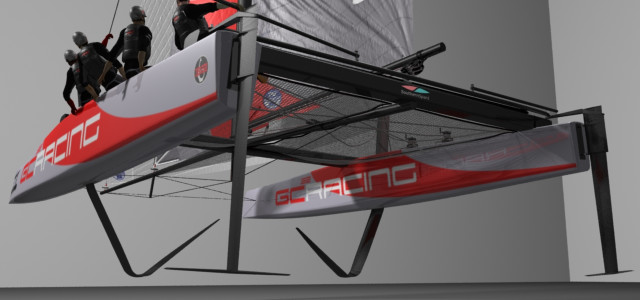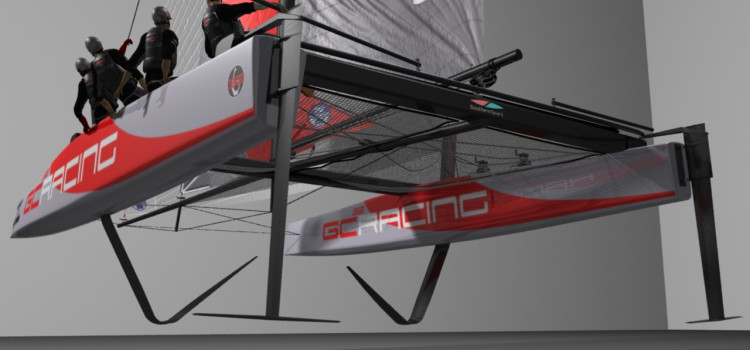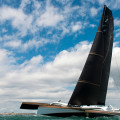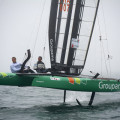

The Great Cup GC32, new L-foils to start flying in 2014
EnglishGC32MultiscafiVela 14 Novembre 2013 Zerogradinord 0

Video courtesy The Great Cup.
London – After a successful first season competing at regattas across Europe, The Great Cup’s GC32 catamarans are to receive a foil upgrade this winter, a change set to transform the twin-hulled speedsters into full foilers in above 8 knots of wind. The new L-foils will enable the one design GC32s to race elevated from the water, in a similar gravity-defying fashion to the AC72 catamarans that caused such a phenomenon at the 34th America’s Cup in San Francisco this summer.
“Our focus has always been to deliver a sustainable product for our owners,” explains Laurent Lenne, founder of The Great Cup and skipper of the SPAX Solutions GC32. “When we started the project, the AC boys were only talking about foiling. Now their boats are flying, it is our duty to close this gap by changing our boats so that they can fly too.”
This year Martin Fischer, designer of the GC32, has been working as part of Franck Cammas’ design team that transformed one of Fischer’s own Phantom F18 catamaran design into a full foiler. This project was a test bed for Groupama C, the foiling 25ft long C-Class catamaran aboard which Cammas decisively won the International C-Class Catamaran Championship in Falmouth, England in September.
This experience greatly benefitted the GC32 team in creating its new foils. “I believe we did our homework very well to make this step,” continues Lenne. “Many hours were spent developing the right shape, with the right engineering and build costs.”
L-foils of this type represent the most cutting edge technology in sail boat design at present and it is no mean feat to get right. AC72 foils cannot be directly scaled down to work on a substantially smaller and lighter weight boat. Also the aim of the GC32 is different from an AC72: While the latter is a highly complex machine designed to be raced solely by experienced professionals, the GC32 is targeted at sailors of average proficiency or above and should be much easier to sail.
Key to achieving this is fitting foils that will provide a stable ride without constant porpoising. Martin Fischer explains how this is achieved: “Ride height, or ‘heave’, stability is an essential feature of every foiling boat. This can either be obtained with an active control system – like the wand mechanism on a Moth – or with a foil design that is inherently stable. With the GC32 we went for that second option.”
This heave stability depends primarily on the angle between the vertical strut and horizontal tip of the L-shaped daggerboard: Essentially the smaller the angle between strut and tip, the more stable the ride, but this does come at the cost, says Fischer: “It is important to find the right trade-off between heave stability, safety and controllability on one side, against drag and theoretical speed on the other. A foil with a wider strut-tip angle may be theoretically quicker, but that does not help if the foil is so difficult to handle that its full potential cannot be exploited.” As some America’s Cup teams discovered during their early attempts to foil.
Thus the new GC32 foil will have a moderate angle between its vertical strut and tip, the heave stability further improved by varying the wing section along the foil’s span.
Results of Fischer’s research to date indicate that the new foils will offer the same performance as before below 8 knots of wind. 8 knots, when the GC32 should be making 17 knots boat speed (ie more than two times wind speed), is all that is required to get her foiling. Beyond this the speed gain from lifting the boat clear of the water will be 5-7 knots, with a top speed into the mid-30s.
Compared to the AC72 set-up, controls for the GC32 boards will also be simplified. The boards will go up and down and their rake (fore and aft inclination) can be adjusted. Fortunately the GC32’s original ‘double S’ daggerboards are already set up with a rake control. Similarly while the change of foils maybe significant, the cases into which they fit will require just a change of roller to accept the new boards.
The GC32’s new L-foils are currently under development with the first prototypes set to be tested during December and January. After this phase has concluded, production foils will be built ready for the start of the 2014 season.
Andrew Macpherson, COO of The Great Cup summarises: “After an exciting first season we are now entering the next phase for the class where we can leverage the lessons from developments in the last AC cycle and apply them to the GC32. Our approach to have an auto-stabilising foil solution was reinforced after observing the similar approach that Franck Cammas and his team took with their C-Class. With a well behaved boat they were able to access the available performance and proved that this was the correct path.”
“Over the next months we will focus on refining the control systems so that the boat is optimised for racing, special attention being applied to the management of the foils in close racing situations. We are lucky that the GC32 was designed from the outset to handle the loads of full flight and we also have the rudder pitch adjustment built into the boat from day one.”
The GC32’s existing L-foil rudders are also going through a makeover this winter and will be replaced by T-foils, as on the AC72s.
Laurent Lenne concludes: “I simply cannot wait to see a fleet of flying GC32s on the start line next year. We are working at the moment on venues for our 2014 circuit in Europe and expect to finalise the program a few weeks from now. Add to this our innovative ITC live streaming and on board media system and I believe 2014 is going to be an amazing year for The Great Cup.”





No comments so far.
Be first to leave comment below.